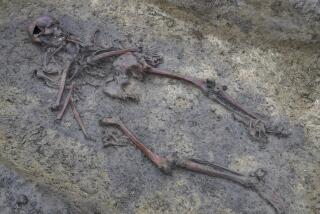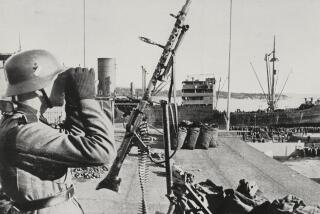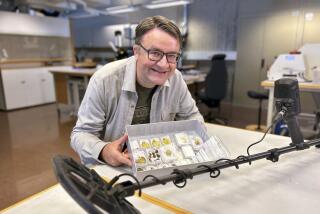Helge Ingstad; Proved Vikings Sailed to America
- Share via
Helge Ingstad, a Norwegian scholar and explorer whose discovery that Vikings landed in North America 500 years before Christopher Columbus turned Norse myth into historical fact, died Thursday in Oslo. He was 101.
When Ingstad found a Viking settlement in northern Newfoundland in 1960, it was a watershed in New World history that ended centuries of wondering about where the legendary seafarers had gone in their travels and shattered beliefs in the novelty of Columbus’ journey.
Ingstad’s achievement was made even more amazing by the fact that he was not an archeologist by training. Born in Bergen, a city on Norway’s west coast, Ingstad earned a law degree in 1922 but abandoned his practice for a more adventuresome life.
He lived as a trapper in Arctic Canada, studied the Apaches in Arizona, searched for a “lost tribe” in the Sierra Madre of Mexico and lived with Eskimos in Alaska. In the 1930s he became governor of eastern Greenland, then claimed by Norway, and later served as governor of Svalbard, an island separated from Norway by the Barents Sea.
By the early 1950s, he had begun looking for Viking outposts along the coast of western Greenland, correlating geography with information from the Viking sagas about the discovery of North America. He became steeped in Viking folklore, which told how Eric the Red, an Icelandic settler and son of an exiled murderer, found Greenland in 982 and how, two decades later, Eric’s son, Leif Ericson, embarked on his own investigation of a sighting of land to the west.
According to the legend, Ericson found Baffin Island and called it Helluland. Then he discovered Labrador, which he called Markland. Pushing south, he stopped at a grassy land where he and his crew found wild wheat and grapevines. Called Vinland in the sagas, this was a place where the seafaring Vikings were said to have built “great houses” and spent the winter before returning to Greenland.
But where was Vinland? And were the Norse tales about it historical fact or literary fantasy? Such questions had fueled debate since European scholars began studying the sagas in the 19th century. When those studies led to the discovery of a failed Norse colony in Greenland, speculation grew that other signs of Viking habitation might exist as far south as Massachusetts, Rhode Island and New York, but none was ever found.
Resisting conventional wisdom, Ingstad began to suspect that Vinland was in northern Newfoundland, even though grapes had never grown there. Armed with an ancient Icelandic map, he set off on a history-making quest. Over many months, he scoured thousands of miles of North Atlantic coast by boat, plane and foot. He met nothing but disappointment.
Then, in 1960, he heard of some ruins near a tiny fishing village named L’Anse aux Meadows, on Newfoundland’s northernmost tip.
“I felt as if I had hooked a large salmon,” Ingstad wrote in “Westward to Vinland,” the 1969 account of his explorations. “It was not only that L’Anse aux Meadows was situated on the north coast, but I also remembered that when we sailed past it I had noticed the open, inviting verdant countryside. And I thought of ‘Meadows,’ which is the same as ‘grasslands’ or the old Norse vin, just what the Norsemen were looking for.”
His hunches led him to a man named George Decker, whose family had lived in the village for generations. Decker steered him west of the village to a site by a shallow bay, unwelcoming to fishermen but no impediment to Viking ships, which could have been pulled ashore. Decker told Ingstad that no one had ever dug there.
Ingstad could see the remains of very old sod huts, barely visible under the tall grasses and wild berry bushes. Locals long thought the huts had been built by an indigenous tribe.
When the Norwegian set eyes on the site, something resonated from his years as an Arctic trapper and explorer.
“There was so much here at L’Anse aux Meadows,” he wrote, “that reminded me of what I had seen of the surroundings of Norse farms in Greenland: the green fields, the rippling stream, the open country, the view of the sea, and perhaps something else that was not so easy to fathom. Here, the people from the Arctic island would have felt at home.”
Over the next seven years, under the leadership of his wife, archeologist Anne Stine, the site was excavated. The outlines of eight structures with immense walls were found. Though built in the style of Icelandic houses, they alone were not enough to tie the settlement to the Vikings. It would take four years of digging to do that.
On Aug. 14, 1964, two members of the excavation crew, Birgitta Wallace and Anthony Beardsley, discovered a smooth soapstone object with a hole in it. It turned out to be a Norse spindle-whorl, used throughout medieval Scandinavia as the weight in a device that spun wool into yarn. It was irrefutable proof linking the site to the Norse travelers.
At first the Ingstads were accused of having faked their finds. The clear implication was that the Vikings had been the first white men to set foot in North America, but every schoolchild knew that Christopher Columbus had discovered America.
But when radiocarbon analysis dated objects found there to between 980 and 1020, the time of Leif Ericson’s and later expeditions, the Ingstads’ feat could not be disputed.
“The discovery of that site changed fiction into fact,” said William Fitzhugh, director of the Arctic Studies Center at the Smithsonian Institution.
After a century of argument over Vinland, it was Ingstad who put it on the map.
“It was like Heinrich Schliemann discovering Troy, one of the most heroic events in archeology,” Fitzhugh said.
L’Anse aux Meadows remains the only documented Norse settlement in North America. In 1980 it was declared a UNESCO World Heritage site, a designation placing it on a par with the pyramids of Egypt and the Grand Canyon.
Stine, Ingstad’s wife of 56 years, died in 1997.
Last year, the 100-year-old Ingstad traveled from Norway to be a special guest at the opening of a $3-million Viking exhibit at the Smithsonian’s National Museum of Natural History. The traveling show, called “Vikings: The North Atlantic Saga,” will open at the Los Angeles County Museum of Natural History on Nov. 23.
More to Read
Sign up for Essential California
The most important California stories and recommendations in your inbox every morning.
You may occasionally receive promotional content from the Los Angeles Times.














